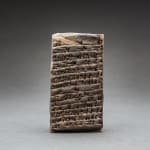Old Babylonian Terracotta Cuneiform Tablet, 1817 BCE - 1794 BCE
Terracotta
1.87 x 3.62
LO.1256
Further images
The tablet contains 29 lines of Sumerian cuneiform on obverse and reverse and also has cylinder seal impressions on the reverse above the date and on upper, lower and left-hand...
The tablet contains 29 lines of Sumerian cuneiform on obverse and reverse and also has cylinder seal impressions on the reverse above the date and on upper, lower and left-hand edges. It is dated to the year in the reign of Damiq-ilishu, king of Isin in southern Mesopotamia, c. 1817-1794 B. C., but the precise date in his reign cannot yet be established, for lack of a list of year names covering the whole reign.
Translation:
2 musar of neglected land, land Ahatum, Nabi-Shamash, Nishinishu and Ipiq-Ersetum, adjacent to (land of) Beli-tayyar:
2 shekels of silver were weighed out as its full price. Ibbi-Ninshubur, son of Puzur-Ninkarrak, purchased it from Ahatam, Nabi-Shamash, Ipqu-Ersetum and Ninshinishu, children of Sin-gamil.
In the future Ahatum, Nabi-Shamash, Ipqu-Ersetum and Nishinishu, children of Sin-gamil, may not claim the land. They swore by the king.
In the presence of Ta……, son of Shu-Isha Ili-bani, son of Yadda-waqa Sin-eresh, son of Ubar-Bab Nanna-ME-BARA, son of Ahi-waqa Ilum-milik, son of Nanay
Seal inscription:
Ahatu Wife of Sin-gami
Month: Iyar, year: Damiq-ili the king installed Ninzi-anna.
The tablet is in excellent condition for the obverse, but there is a little damage to the reverse involving the list of witnesses. The ancient scribe took a short cut in one respect: the property sold was jointly owned by a woman (Ahatum) and three men, and all four in the wording of the document are described as children of Sin-gamil, but only one seal inscription is rolled, that of Ahatum, “wife of Sin-gamil.” The seal is no doubt correct, and the scribe saved himself trouble by making mother and three sons all “children of Sin-gamil.” The installation in the year name refers to a high priestess.
Description and translation kindly provided by Professor W. G. Lamber
Translation:
2 musar of neglected land, land Ahatum, Nabi-Shamash, Nishinishu and Ipiq-Ersetum, adjacent to (land of) Beli-tayyar:
2 shekels of silver were weighed out as its full price. Ibbi-Ninshubur, son of Puzur-Ninkarrak, purchased it from Ahatam, Nabi-Shamash, Ipqu-Ersetum and Ninshinishu, children of Sin-gamil.
In the future Ahatum, Nabi-Shamash, Ipqu-Ersetum and Nishinishu, children of Sin-gamil, may not claim the land. They swore by the king.
In the presence of Ta……, son of Shu-Isha Ili-bani, son of Yadda-waqa Sin-eresh, son of Ubar-Bab Nanna-ME-BARA, son of Ahi-waqa Ilum-milik, son of Nanay
Seal inscription:
Ahatu Wife of Sin-gami
Month: Iyar, year: Damiq-ili the king installed Ninzi-anna.
The tablet is in excellent condition for the obverse, but there is a little damage to the reverse involving the list of witnesses. The ancient scribe took a short cut in one respect: the property sold was jointly owned by a woman (Ahatum) and three men, and all four in the wording of the document are described as children of Sin-gamil, but only one seal inscription is rolled, that of Ahatum, “wife of Sin-gamil.” The seal is no doubt correct, and the scribe saved himself trouble by making mother and three sons all “children of Sin-gamil.” The installation in the year name refers to a high priestess.
Description and translation kindly provided by Professor W. G. Lamber







